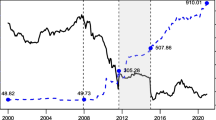Abstract
This paper investigates the recent evolution of five Eastern European exchange rates. Our aim is twofold: to provide an up-to-date view of the predictability and main relations of spot rates with economic fundamentals and to derive some considerations about exchange rate regimes, capital flows, and risk appetite. We propose a non-linear specification where the non-linearity refers to the effect of the interest rate differential. The paper supports the view that given the relevance of capital flows and their sensitivity to risk adjusted yield differentials, the choice of exchange rate regime should be a matter of careful strategy.
Similar content being viewed by others
References
Begg, D. and C. Wyplosz (1999) “Why Untied Hands are Fundamentally Better.” Paper Written for the Fifth Dubrovnik Conference on Transition Economies, June 23–25, 1999.
Bacchetta, P. and E. van Wincoop (2000) “Does Exchange Rate Stability Increase Trade and Welfare?” American Economic Review 90:1093–1109.
Bruchàéovà, A. (2000) Comparison of Economic and Monetary Development of Slovakia the Czech Republic, Hungary, Poland and Slovenia. Institute of Monetary and Financial Studies of the NBS.
Chinn, M.D. (1999) “A Monetary Model of the South African Rand.” African Finance Journal 1.
Chinn, M.D. (2000) “Testing Uncovered Interest Parity at Short and Long Horizons.” SCCIE Working Paper 2000-11 (July 2000).
Corker, R., C. Beaumont, R. van Elkan, and D. Iakova (2000) “Exchange Rate Regimes in Selected Advanced Transition Economies—Coping with Transition Capital Inflows, and EU Accession.” IMF Working Paper 00/3.
Dornbusch, R. (1976) “Expectations and Exchange Rate Dynamics.” Journal of Political Economy.
Economics Department Monetary Authority of Singapore (2000) “Exchange Rate Policy in East Asia After the Fall: How Much Have Things Changed?” Occasional Paper, No. 19.
Edwards, S. and M.A. Savastano (1999) “Exchange Rates in Emerging Economies: What Do We Know? What Do We Need to Know?” NBER Working Papers, WP 7228.
Frenkel, J. and M. Mussa (1985) “Asset Markets, Exchange Rate and the Balance of Payments.” Handbook of International Economics. Vol 2, Chapter 14.
Frenkel, J. (1999) “No Single Currency Regime is Right for All Countries or at All Times.” NBER Working Papers, WP 7338. Essays in International Finance, No. 215. Princeton University Press.
Grafe, C. and C. Wyplosz (1997) “The Real Exchange Rate in Transition Economies.” CEPR Discussion Paper, No. 1773.
Halpern, L. and C. Wyplosz (1997) “Equilibrium Exchange Rates in Transition Economies.” International Monetary Fund Staff Papers 44(4):430–461.
Krajnyak, K. and J. Zettelmeyer (1998) “Competitiveness in Transition Economies: What Scope for Real Appreciation?” IMF Staff Papers, Vol. 45, No. 2.
Levich, M.R. (1985) “Empirical Studies of Exchange Rates: Price Behavior, Rate Determination and Market Efficiency.” Handbook of International Economics, Vol. 2, Chapter 19.
Juselius, K. (1995) “Do Purchasing Power Parity and Uncovered Interest Parity Hold in the Long Run?” An Example of Likelihood Inference in a Multivariate Time-Series Model, Journal of Econometrics 69:211–240.
Masson, P.R. (1999) “Monetary and Exchange Rate Policy of Transition Economies of Central and Eastern Europe After the Launch of EMU.” IMF Working Paper 99/5.
Mussa, M. et al. (2000) “Exchange Rate Regimes in an Increasingly Integrated World Economy.” IMF; April 2000.
NBP (1998) Monetary Policy Guidelines for 1999. National Bank of Poland.
NBP (1998) Monetary Policy Guidelines for 1999–2003. National Bank of Poland.
Nessén, M. (1997) “Exchange Rate Expectations, the Forward Exchange Rate Bias and Risk Premia in Target Zones.” Open Economies Review 8(2):99–136.
Obstfeld, M. and K. Rogoff (1996) Foundations of International Macroeconomics. Cambridge: The MIT Press, pp. 605–658.
Smidkova, K. (1998) “Koruna Exchange Rate Turbulence in May 1997.” CNB Working Papers, WP N. 2.
Temprano-Arroyo, H. and R. Feldman (1998) “Selected Transition and Mediterranean Countries: An Institutional Primer on EMU and EU Relations.” IMF Working Paper, 98/82.
Wesso, G.R. (1999) “The Forward Rate as an Optimal Predictor of the Future Spot Rate in South Africa: An Econometric Analysis.” Occasional Paper, No. 13, South African Reserve Bank.
Wyplosz, C. (2000) “Ten Years of Tranformation: Macroeconomic Lessons.” CEPR Discussion Paper, No. 2254.
Author information
Authors and Affiliations
Rights and permissions
About this article
Cite this article
Brasili, A., Sitzia, B. Risk Related Non Linearities in Exchange Rates: Evidence from a Panel of Central and Eastern European Countries. Open Economies Review 14, 135–155 (2003). https://doi.org/10.1023/A:1022309913015
Issue Date:
DOI: https://doi.org/10.1023/A:1022309913015




